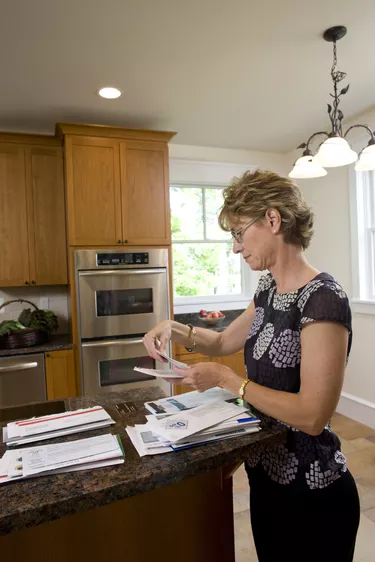
If you're like most people, you have a variety of different bills all due on different days of the month. Trying to keep all of that information in your head can be difficult, and may result in late fees or penalties if you forget to pay your bills on time. Making your own personalized household bill chart will make it much easier to pay bills on or before the due date and help you budget how much money you need to put aside each month for payments.
Step 1
Gather all of your recurring bills from the previous month or billing cycle. Organize them by the date that they are due each month or billing cycle, starting with bills due at the beginning of the month and following through to bills that are due toward the end of the month.
Video of the Day
Step 2
Divide a sheet of paper into thirds using a pen or marker and a ruler or create a spreadsheet document with three sections. Mark the left column with the name of each bill in ascending order by due date. For example, if your cable bill is due before your other bills each month, mark "Cable" or the name of your service provider at the top of the far left column. Continue marking the left column, leaving a small amount of space between each bill listed.
Step 3
Mark the second column with the due date of each bill. Keep the due dates on the same line as the name of the bill so it will be easy to read. If you prefer, you can use a different color pen, marker or type of ink for due dates. Move down the chart until you've added due dates next to all recurring bills.
Step 4
Put the amount of each bill in the third column next to the due date, using a separate color if you wish. If the bill isn't an exact amount each month, as is often the case with utility bills based on usage, use an estimate based on last month's bill or a bill from the same month last year.
Step 5
Add the amount or estimated amount of your bills using a calculator and put the total beneath the last bill amount in the third column. These are your standard monthly expenses for household bills.
Step 6
Print the household bill chart if you used a computer to create a spreadsheet. Keep your household bill chart in a convenient place where it will remind you when to pay your bills. Cross the bills off after you've paid them.
Tip
Using the same method, you can make a chart for bills that aren’t recurring, such as doctor, dentist or one time service charges or set-up fees. You can also write in one time bills using a pen or pencil in the spaces between your recurring bills.
Things You'll Need
Paper
Pen or marker, multiple colors if desired
Ruler
Computer, optional
Calculator
Printer, optional
Video of the Day